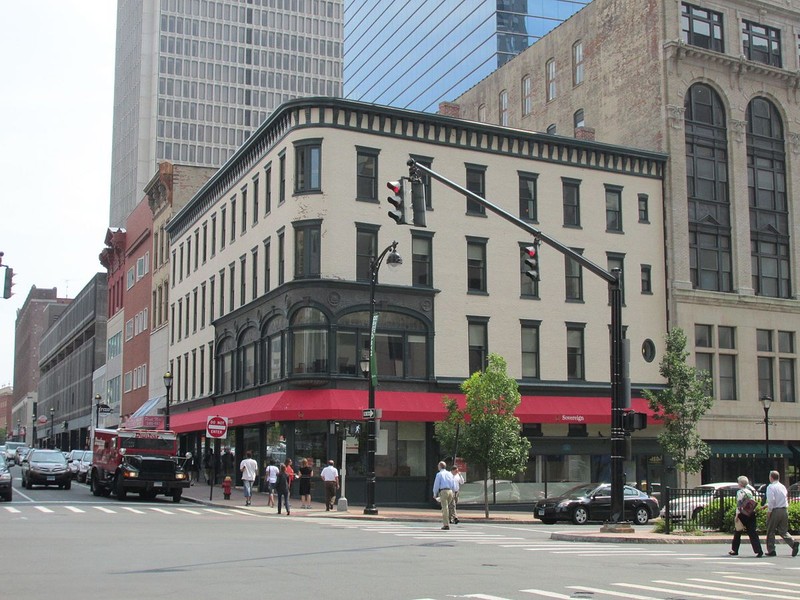Stackpole, Moore, and Tryon Building
Introduction
Text-to-speech Audio
Built in the mid-19th century, the cast-iron facade of Hartford's Stackpole, Moore, and Tryon Building demonstrates the influence of the Industrial Revolution as well as the changing styles of leading architects in Chicago and New York that were influencing leading regional cities. A renovation in 1896 included a new cast-iron front with Beaux-Arts influence, a style made popular during the Chicago Columbian Exposition in 1893.
Images
2013 Image of the Stackpole, Moore, and Tryon Building in Hartford, CT. Built in the mid-19th century, its cast-iron facade demonstrates the influence of the Industrial Revolution and architects in Chicago and New York.

Backstory and Context
Text-to-speech Audio
Hartford's Stackpole, Moore, and Tryon Building is a mid-nineteenth-century commercial structure that is distinguished by a cast-iron facade. The building's design reflects the Beaux-Arts influence that led to the addition of this facade during the 1890s (completed in 1896). The cast-iron addition speaks to the impact of Industrial Revolution, New York construction, the Chicago School of Architecture, and the 1893 Chicago Columbian Exposition on urban architectural design
The Stackpole, Moore, and Tryon name arose in 1909 when the group became tenants of the building, replacing Willis and Wilson, who occupied it at the time of the cast iron addition. One will also find a plate at the base of the engaged column east of the store entrance with the words, "Lincoln & Co.," the shop which manufactured the cast-iron front.
While tenants have come and gone, the last sale of the premises occurred in 1852 when Mary G. Arnold sold the property to Timothy M. Allyn for $4,000. Although the deed makes no mention of any structure located on the land, the price indicates a building stood on the property. For sure, the building arose before 1869 as a city atlas in 1869 includes the structure that now deemed historic.
Cast-iron architecture grew popular in New York during the late 1800s, with its primary function as facades for commercial buildings. Initially, cast-iron facades were a simple post and lintel design but quickly transitioned to the more popular and ornate Italianate style. Toward the end of the century, as demonstrated by the Stackpole, Moore and Tryon building, fluted columns, Ionic volutes, and other features associated with the Beaux-Arts style began to dominate, largely a result of the influence of the 1893 Chicago Columbian Exposition.
Cite This Entry
Powers, Mathew and Clio Admin. "Stackpole, Moore, and Tryon Building." Clio: Your Guide to History. November 24, 2018. Accessed April 15, 2025. https://theclio.com/entry/69754
Sources
Condit, Carl W. "Sullivan's Skyscrapers as the Expression of Nineteenth Century Technology." Technology and Culture 1, no. 1 (1959): 78-93. doi:10.2307/3100790.
Gayle, Carol and Margot Gayle. Cast-Iron Architecture in America: The Significance of James Bogardus. New York: W. W. Norton & Company, 1998.
Ransom, David F. "Nomination Form: Stackpole, Moore, and Tryon Building." National Register of Historic Places. August 2, 1977. https://npgallery.nps.gov/NRHP/GetAsset/NRHP/78002869_text
Photo Source
By John Phelan - Own work, CC BY-SA 3.0, https://commons.wikimedia.org/w/index.php?curid=28249852
Photo Source
By John Phelan - Own work, CC BY-SA 3.0, https://commons.wikimedia.org/w/index.php?curid=28249852

